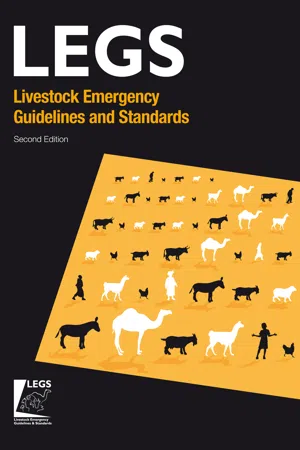
- English
- ePUB (mobile friendly)
- Available on iOS & Android
Livestock Emergency Guidelines and Standards 2nd Edition
About this book
The LEGS process grew out of the recognition that livestock are a crucial liveli¬hood asset for people throughout the world – many of whom are poor and vulnerable to both natural and human-induced disasters – and that livestock support is an important component of emergency aid programmes.The publication of the first edition of LEGS in 2009 responded to the need to help donors, programme managers, technical experts, and others to design and implement livestock interventions in emergencies. At the same time, LEGS recognized the need to plan for climatic trends affecting communities that rely heavily on livestock. The first edition drew on multi-agency contributions, on wide-ranging reviews, and on collations of practitioner experiences of using evidence-based good practice. This second edition builds on the first edition by incorporating new experiences and evidence obtained since 2009 as well as user feedback provided as a result of a broad consultation process.
Frequently asked questions
- Essential is ideal for learners and professionals who enjoy exploring a wide range of subjects. Access the Essential Library with 800,000+ trusted titles and best-sellers across business, personal growth, and the humanities. Includes unlimited reading time and Standard Read Aloud voice.
- Complete: Perfect for advanced learners and researchers needing full, unrestricted access. Unlock 1.4M+ books across hundreds of subjects, including academic and specialized titles. The Complete Plan also includes advanced features like Premium Read Aloud and Research Assistant.
Please note we cannot support devices running on iOS 13 and Android 7 or earlier. Learn more about using the app.
Information

and emergencies
- •Why are livestock projects important to humanitarian response?
- •How do different types of emergency affect people who keep livestock?
- •How does LEGS link with a rights-based approach?
- •What are the livelihoods objectives of LEGS?
Table of contents
- Cover
- Title
- Copyright
- Contents
- Praise for this book
- Introduction to LEGS and how to use this book
- 1. Livestock, livelihoods, and emergencies
- 2. Core standards and cross-cutting themes common to all livestock interventions
- 3. Initial assessment and identifying responses
- 4. Technical standards for destocking
- 5. Technical standards for veterinary support
- 6. Technical standards for ensuring feed supplies
- 7. Technical standards for the provision of water
- 8. Technical standards for livestock shelter and settlement
- 9. Technical standards for the provision of livestock
- Annexes